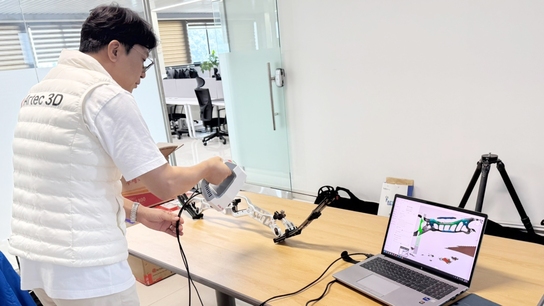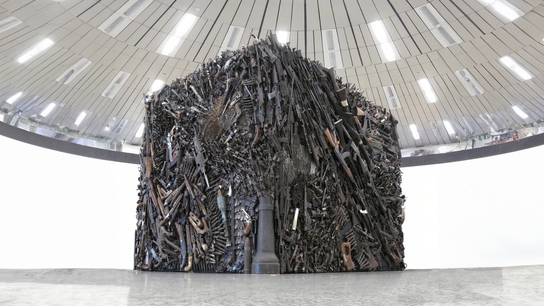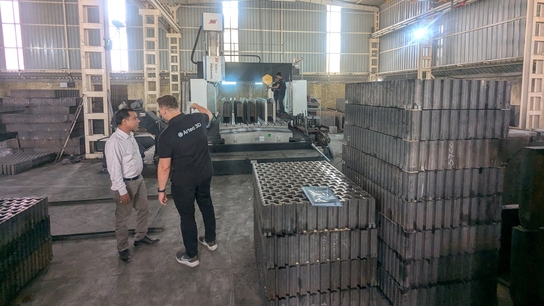Reverse engineering “almost impossible” to make aircraft spares with Artec 3D scanning
Challenge: Digitizing the untextured, organic surfaces of a vintage aircraft with sufficient precision to develop a digital copy that – if needed – can be used to create functional spares.
Solution: Artec Leo, Artec Studio
Result: An incredibly detailed 3D model that fully captures the craft’s shiny, featureless fiberglass cockpit, and preserves its unique, experimental design in virtual form.
Why Artec 3D?: Without the industry-first wireless Artec Leo, capturing the Sadler Vampire’s intricate, partially obscured geometry would be nearly impossible. Using the Artec Studio software’s advanced editing tools, such complex surfaces can later be tidied up with the few clicks of a button, yielding a highly detailed mesh primed for reverse engineering.

A test pilot in the Sadler Vampire light aircraft. Image via Wikimedia Commons
Ever dreamt of taking to the skies in your own plane and flying to a new part of the world whenever you wanted to? The prospect of such unbound freedom has inspired innovation across aviation, and the industry is littered with attempts to make this fantasy a reality.
Since the LearJet 23 launched in 1964, popularizing private jets, designs have advanced at pace, with some targeting ever more luxurious air travel and others prioritizing utility.
One of the more inventive of these planes arrived in the 1980s: the Sadler Vampire. Unlike many peers, it featured foldable wings and a pod-and-boom layout. To this day, the craft remains popular among recreational pilots, and its design has been repurposed many times; at one point, this even saw a machine gun-mounted ‘Piranha’ version introduced.
However, the plane’s experimental nature meant its design was never preserved in CAD form, and it’s becoming difficult to source spares. Amid looming supply issues, one pilot has tried to stay ahead of the game – by digitizing their entire Sadler Vampire with Artec 3D scanning.
Digitizing an aviation icon
Since selling their first Sadler Vampire decades ago, the pilot in question has become more mindful of the craft’s rarity. So, just in case anything were to break or they wanted to make modifications of their own, they thought it best to create a digital design ‘baseline.’
While the aircraft’s wing structure features ridges, making it fairly easy to digitize, its white pod-like cockpit is rivet-free, textureless, and made from reflective fiberglass. Photogrammetry capture was one option, but the resulting model would’ve required significant cleanup.
Having reached out to 3DMakerWorld for help, Artec’s long-standing US partner suggested an alternative: adopting Artec Leo. Although Artec Space Spider could also have captured the plane with the precision needed for reverse engineering, Leo’s 35 million pts/sec scan speed, built-in display, and cable-free versatility made it better suited for the job.

3DMakerWorld’s Chad Mees digitizing the pod section of a Sadler Vampire with Artec Leo. Image courtesy of 3DMakerWorld
“We had a fragile setup, it was on an engine stand with a long beam through it. So I had to maneuver around that,” explained 3DMakerWorld engineer Chad Mees. “With Artec Leo, it was easy to invert, insert it into cavities and capture internal features. Using its built-in screen, I could also watch what I was doing and not run into anything!”
Another advantage of adopting Artec 3D scanning was the high level of accuracy the team were able to achieve, without needing tracking targets or markers. This ensured that the Sadler Vampire would not be damaged during digitization, streamlined their workflow, and made it possible to capture all the data required in minutes.
Scan-to-CAD in Artec Studio
For advanced reverse engineering, firms often invest in additional tools like those offered by Geomagic for SOLIDWORKS, but in this case, Artec Studio’s proved more than enough.
In particular, Mees says the 3D scanning and scan data processing software’s defeature brush was great for eliminating artifacts. Doing so would normally be challenging due to the cockpit’s organic shape, but with this tool, he could ensure that part surfaces fit perfectly.

A 3D mesh of the Sadler Vampire’s curved cockpit. Image courtesy of 3DMakerWorld
“In some spots, where we may have had small artifacts, we were able to remove them with Artec Studio’s smoothing tools,” said Mees. “Where scans didn’t quite meet perfectly, the software was also able to connect surfaces easily. Cleanup was very straightforward.”
“Our cleanup, which involved all these different components, was achieved entirely in Artec Studio. I didn’t need to do any other mesh editing.”
Looking back, he believes Artec Studio’s surface thickening tools could’ve made the process even easier. The Vampire featured many narrow geometries, where capturing both sides was very tricky – an issue that could’ve been overcome by adding thickness in certain places.
But even without this feature, the resulting mesh could ultimately be exported and turned into a fully textured 3D model, with the level of fine detail needed for reverse engineering.

A 3D mesh of an individual intake extracted from the Sadler Vampire. Image courtesy of 3DMakerWorld
Analysis & upgrade opportunities
Moving forward, it’s thought that Leo could have further aircraft 3D scanning potential, especially in the fields of non-destructive testing (NDT) and computational fluid dynamics (CFD).
Even if you were able to manually create a perfect model of a plane like the Vampire, Mees says this “wouldn’t really show you if it was produced correctly.” With Artec 3D scanning, on the other hand, he says you can capture curved bodies and feed resulting data into a CFD simulation that allows you to analyze how turbulent air affects craft performance.
For the time being, the owner of the Vampire isn’t planning any CFD analysis, but they do now have a design file they can revert to in case they decide to make upgrades or need spares.
“Artec Leo was absolutely the animal for this because of its wider field of view and maneuverability,” added 3DMakerWorld 3D scanning consultant Kevin Stucky. “It would’ve been quite a pain to get inside enclosed spaces or drag a laptop into our setup. The scan was also noise-free and the incredible flexibility of Leo was very cool to see.”
“Getting the exact measurement (like we got here) would be almost impossible if we didn’t use Artec Leo 3D scanning.”
Scanners behind the story
Try out the world's leading handheld 3D scanners.





